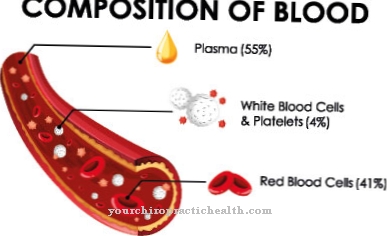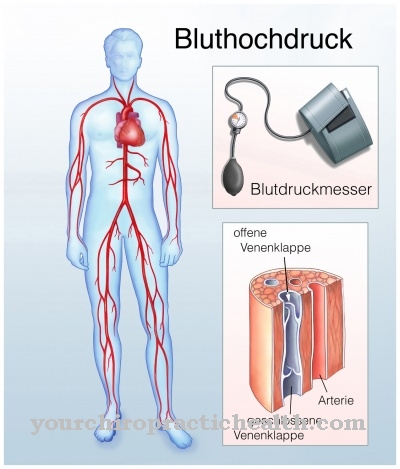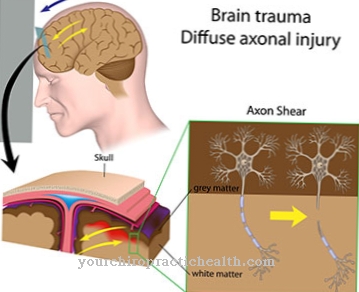The Water hives is a dermatological reaction to contact with water. Those affected show swollen and itchy wheals on the skin after contact with water. The administration of antihistamines to alleviate the symptoms is a therapeutic option.
What is water hives?
The hives are a dermatological reaction. It is a skin reaction that the body produces when it comes into contact with allergens. The skin reaction corresponds to point-like, button-like or reddened wheals and erythema, which are caused by allergic processes of the dermal blood vessels.
Hives are not only associated with drugs, food, psychological stress or immunological phenomena. The symptoms described can also occur as a reaction to contact with heat, light, pressure or water. Depending on the cause, medicine distinguishes different types of hives. The Water hives is one of them.
In this aquagenic form of urticaria, the skin reacts to the action of water with a rash. The rash often appears seconds after contact and lasts an average of two hours. In addition to congenital forms of water hives, acquired forms of the disease have been observed. Some patients report a gradual decrease in symptoms over the course of their lives.
The water nettle rash is a rather rare form of the hives and was first described in the middle of the 20th century. Shelley and Rawnsley are considered to be the first descriptors. According to a British tabloid, only 35 cases worldwide are said to have been documented after the initial description.
causes
The water nettle rash is sometimes counted among the allergies. But that is not entirely true. Allergies are characterized by the release of the neurotransmitter histamine, which causes the characteristic defense reactions. Water hives are often, but not always, associated with the release of histamine.
Therefore, it is probably not an actual water allergy, but rather a dermatological reaction to substances such as chlorine or certain ions such as those found in non-distilled water. Some of the cases documented so far suggest a genetic disposition for water hives. A familial accumulation was sometimes observed. The examination of the reactions in twin pairs speaks in favor of a genetic disposition.
In addition to the genetic form of water hives, there is apparently also a non-hereditary form, such as is assumed for the acquired species of water hives. Since the majority of the patients documented so far were isolated individual cases with no familial accumulation, the sporadic occurrence of the symptoms seems to be the more common variant. The causal relationships have not been conclusively clarified for this variant.
Symptoms, ailments & signs
Patients with aquatic hives react to contact with water with symptoms similar to those caused by contact with nettles. Around 15 minutes after contact, whitish papules of small size appear at the points of contact with the water, which often persist for two hours. Concomitant symptoms are usually more or less severe itching.
Slight reddening of the surrounding skin areas was also observed on the patient. Not every type of water has to trigger these reactions. Often only rainwater causes the skin changes. Other patients only react to contact with sea water. However, some people also report regular rashes after showering. Only in exceptional cases does the type of water play no role in the reaction.
The clinical picture of skin reactions can vary significantly from case to case. In addition to the color changes and the itching, some patients have swelling, for example, which is mostly due to the increased release of the messenger substance histamine. Whether and how much histamine the patients release in contact with water differs from case to case.
Diagnosis & course of disease
The diagnosis of water hives is first made by the doctor based on the medical history. In order to confirm such a suspected diagnosis on the basis of the anamnesis, compresses at body temperature, which have been soaked with water, are applied to the patient. If the skin reactions described then show up, the diagnosis is considered confirmed. The prognosis for the patient is usually favorable. In many cases there is an absolute remission of the disease in the course of life.
Complications
In most cases, water hives will not cause serious complications or discomfort. The symptoms can be treated relatively easily, so that there is no permanent damage. First and foremost, water hives lead to severe reddening of the skin and also to itching in those affected. This can further increase if the patient scratches the skin.
Furthermore, there can also be swelling on the skin. Many patients feel uncomfortable with the symptoms and thus suffer from a significantly reduced self-esteem and also from inferiority complexes. This can lead to bullying or teasing children, so that they develop mental health problems.
If the water urticaria occurs after even a simple contact with ordinary water, this can lead to considerable restrictions in the patient's everyday life. Usually the symptoms of water hives are treated with medication. However, a complete and causal cure is not possible. There are no complications in the treatment. Likewise, this disease does not reduce the patient's life expectancy.
When should you go to the doctor?
A visit to a doctor is necessary for water hives. As a rule, self-healing cannot occur with this disease, so that early diagnosis and treatment always have a positive effect on the further course of the disease. A doctor should be contacted at the first symptoms and signs to prevent further symptoms. A doctor should be consulted in the case of water hives if the person concerned shows very strong reddening of the skin after contact with water. This also leads to severe itching, with the symptoms lasting for several hours.
Likewise, swelling after contact can indicate the hives and should be examined by a doctor. The color of the skin changes not infrequently and indicates this disease. The first diagnosis can be made by a general practitioner or an allergist. Treatment is not always necessary, so the further course depends very much on the severity of the symptoms. Usually, water hives will not reduce the life expectancy of those affected.
Treatment & Therapy
If the hives of the patient can be linked to the release of histamine, the administration of antihistamines is the most important step in therapy. Antihistamines are histamine receptor blockers known as histamine receptor antagonists. The active ingredients in these drugs weaken or even cancel the effect of histamine by blocking the body's own binding sites for histamine.
Antihistamines are available for four different histamine receptors. The drugs are therefore divided into H1, H2, H3 and H4 antihistamines. The H1 and H2 antihistamines show the greatest therapeutic effect and are therefore considered to be the most relevant drugs in the treatment of allergies.
If the skin reactions of patients with hives cannot be traced back to the action of the messenger substance histamine, symptomatic treatment with antihistamines remains unsuccessful. Sometimes causal therapy for water hives is considered in these patients. In this therapy, those affected are regularly exposed to distilled water until the repeated exposure reduces the symptoms.
However, this therapy option is not always successful. The supportive therapy steps include, above all, extensive advice for the patient. The person affected should focus their everyday life on the illness and, for example, keep showers as short as possible.
You can find your medication here
➔ Medicines for rash & eczemaprevention
So far, there are no preventive measures available for water hives because the connections have not been conclusively clarified.
Aftercare
In most cases, the measures of direct follow-up care for water hives are significantly limited, so that the person affected should seek professional medical care so that there are no complications or other complaints in the further course. As a rule, this disease cannot heal itself, so the person affected should contact a doctor at the first symptoms or signs of water hives.
Most of those affected are dependent on taking medication, which can alleviate and limit the symptoms. The doctor's instructions should always be followed, and the doctor should always be contacted first if you have any questions or if anything is unclear. Furthermore, the trigger of water hives should be avoided if possible. Contact with water, such as when showering, should be kept as short as possible so that the symptoms do not recur.
Likewise, the underlying allergy should be treated to alleviate the water hives. Most of those affected depend on the help and care of their own families during treatment. The care can reduce the development of depression and other psychological upsets. As a rule, this disease does not limit or reduce the life expectancy of the person affected.
You can do that yourself
While this condition is extremely rare, it can be torture for those affected. This doesn't just affect the symptoms, itching, or wheals after contact with water, as this allergic reaction can be treated with antihistamines.
But since the disease is usually hereditary, it affects patients from an early age. Unlike their schoolmates, they cannot play with water or go swimming carefree in summer. This can lead to teasing and bullying. In these cases, psychological support is advisable. If the person concerned reacts to all types of water, this can significantly reduce their quality of life. Here the patient has to learn to deal with his situation: to use gloves when coming into contact with water, to wash himself briefly instead of showering, etc.
The symptoms of redness, swelling, and itching are best relieved with cooling. Cooling gel cushions, which are called coolpads in stores, are suitable for this. They are available in pharmacies without a prescription. Coolpads are best kept in the freezer compartment of the refrigerator and removed when necessary. However, they should not be placed directly on the reddened, itchy areas, as they can also draw water and worsen the symptoms. On the other hand, putting on cold Coopads can lead to cold burns. Therefore, the pillows should be wrapped with a towel before hanging.

.jpg)
.jpg)





















.jpg)



